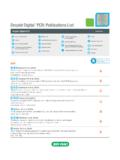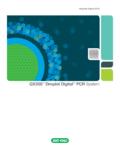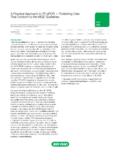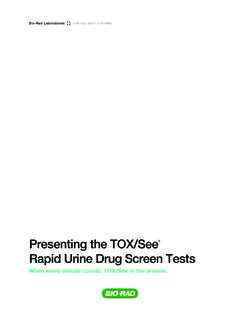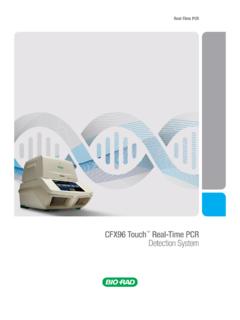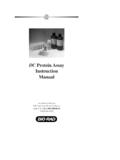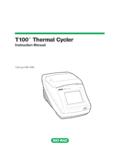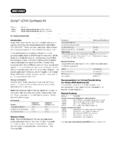Transcription of Post-Transfection Analysis of Cells
1 Post-Transfection Analysis of CellsFlow Cytometry Fluorometry Laser-Scanning Molecular Imaging Luminometry Microscopy Real-Time Quantitative PCR Spectrophotometry Western Blot Analysis References positive Cells within a transfected population (% positive Cells ), and/or visual confirmation of your protein of interest (Jordan et al. 2007).Most methods for measuring protein expression level of your transfected cell will determine the total expression from a population of transfected Cells . Measurement of total gene expression can be done through real-time quantitative PCR (real-time qPCR), western blot Analysis , molecular imaging, and fluorometry. Determining the number of positive Cells within a transfected cell population can be done through microscopy and flow cytometry. Finally, confirming localization of your protein of interest can be done by genes, such as green fluorescent protein (GFP), luciferase, or -galactosidase can be used to analyze transfection efficiency because their expression can be easily monitored.
2 They can also be used to standardize transfection efficiencies between different transfection experiments by comparing the expression levels of their products. Reporter genes can be used alone or fused to a gene of interest to determine the protein expression level, the number of positive Cells , or the location of the protein being present here general guidelines and methods that you can use for the Analysis of transfected Cells . The methods can be used to determine transfection efficiencies and to perform more in-depth analyses of the expression of your favorite gene/protein. However, depending on your Cells , reagents, or equipment availability these methods should be modified to fit your laboratory of Transfected CellsThe advancement of transfection technologies has enabled scientists to investigate protein function and gene regulation in a variety of cell types, tissues, and organisms. transfection is generally achieved by three different methods: chemical, physical, and biological.
3 The choice of the method will depend on the application, the transfected molecule, and the cell type because various Cells may respond differently to a particular method. Once Cells have been transfected, various methods can be used for Analysis Post-Transfection and for assessing transfection are many factors that can influence transfection efficiency, a number of which are specific to the target cell. Cell-related factors affecting transfection include cell density, cell size, replication state, passage number, health of Cells , biomolecule type, and concentration. Some factors are method specific, for example, electroporation parameters such as voltage, capacitance, and resistance strongly affect transfection efficiency. Therefore, to obtain high efficiencies, all relevant factors should be considered when planning transfection , after any transfection experiment, it is important to assess the efficiency of transfection and the impact of transfection on the Cells .
4 Analysis of transfection efficiency can be as simple as confirming the expression of your gene of interest. However, in many cases assessment of transfection involves determining the total expression level of your gene of interest, determining the number of 2010 Bio-Rad laboratories , Inc. 10-0503 Rev AFlow CytometryA flow cytometer can determine the number of positive Cells within a transfected cell population (% positive Cells ). In addition, a flow cytometer with sorting abilities can enrich for positive cell populations. However, flow cytometry requires that the Cells either express a fluorescent protein, such as GFP, or your protein of interest must be labeled with a fluorescent molecule. For more information about flow cytometry, please visit or Limitations E x p e n s i v e Can only detect fluorescence (often requires labeling protein with a fluorescent molecule) Time consuming Advantages Determines percentage of positive Cells (quantitative measurement) Can enrich for positive cell population with sorting abilityFluorometryA fluorometer can detect a wide range of fluorescence.
5 Extracts from Cells expressing fluorescent protein can be used to measure the expression level of your gene in the transfected more information about fluorescent protein detection in cell extracts, please see Measuring Intracellular Enhanced Green Fluorescent Protein With the VersaFluor Fluorometer, Bio-Rad bulletin or LimitationsModerately expensive Can only detect a fluorescent molecule or protein Advantages Able to perform a quick and easy sample detection (direct Analysis of lysate)Can perform quantitative Analysis for total expression Laser-Scanning Molecular ImagingLaser-scanning molecular imagers can detect a wide range of fluorescence. With the use of appropriate fluorophores, western blots or gels can be quantitatively analyzed with a scanner. In addition to analyzing western blots or gels, scanners can also directly detect and quantify lysate from a population of Cells expressing a fluorescent protein, such as GFP.
6 The ability to detect fluorescence allows the scanner to directly analyze cell lysate without running a gel. For more information about laser-scanning molecular imaging, please see Applications for Molecular Imager FX Systems: Instrument Settings, Bio-Rad bulletin or Limitations E x p e n s i v e Can only detect a fluorescent molecule or protein For quantitative Analysis , need an internal control and densitometerAdvantages Able to perform a quick and easy sample detection (direct Analysis of lysate)Can perform quantitative Analysis for total expression LuminometryA luminometer is an instrument that measures light intensity. Expression or co-expression of luciferase, which emits light after interacting with its substrate, can be used for quantitative Analysis of total protein more information about luminometry and luciferase assays, please see Sambrook J and Russell D (2001). Chapter 17: Analysis of gene expression in cultured mammalian Cells .
7 In Molecular Cloning: A Laboratory Manual, 3rd ed. (Woodbury, NY: Cold Spring Harbor Laboratory Press), or LimitationsModerately expensive Luminometer needed Requires expression of luciferase gene (when luciferase assays are used) Only measures total gene expression from population of cellsAdvantages Able to perform a quick and easy sample detection (direct Analysis of lysate with luminometer after addition of substrate) Can perform quantitative Analysis for total expression Microscopy Microscopy allows direct visualization of transfected Cells . Microscopy can be used to count the number of transfected Cells for estimation of positive cell numbers. Microscopy can also be used to confirm correct localization of your protein of interest. Visualization of Cells transfected with your gene of interest can be accomplished in several ways. Expression or co-expression of a fluorescent protein, such as GFP, will allow direct identification of your transfected Cells .
8 However, a non-fluorescent protein must be labeled for visualization. Immunofluorescence, chemical 2010 Bio-Rad laboratories , Inc. 10-0503 Rev Alabeling, and immunohistochemistry techniques can be used to label proteins. In general, microscopy cannot be used for quantitative measurement of transfection efficiency unless you have image Analysis software that can count and quantitate positively transfected more information about chemical and immunofluorescent labeling, fluorescence microscopy, and immunohistochemistry techniques, please visit: or LimitationsExpensive Epifluorence microscope needed Must be able to visualize protein (often requires labeling protein) Time consuming if labeling protein is required AdvantagesVisual (direct observation of your protein of interest) Allows examination of individual Cells Microscopy is the only method that can confirm correct localization of your protein of interest after transfectionReal-Time Quantitative PCRReal-time qPCR can quantify the expression level of a transgene or measure the degree to which a gene silencing (knockdown) experiment has been effective.
9 It is fast and, because it requires little starting material, it is applicable when transfected Cells are available in limited real-time qPCR, one can determine the relative abundance of specific messenger RNA (mRNA) compared to a control. Additionally, real-time qPCR can be used to assess how the knockdown of one gene may affect the expression of other genes in the pathway. However, it does not directly measure or identify the presence of protein. Therefore, any problems post -mRNA synthesis, such as problems during protein translation, will not be identified with this method. As a result, you may observe mRNA production where there may not be any protein synthesis. For more information about real-time qPCR, please see the Real-Time PCR Applications Guide, Bio-Rad bulletin 5279 (catalog #170-9799).Requirements or LimitationsModerately expensive Real-time PCR system needed Protein is not directly measured or identified Advantages Requires little starting material Commonly used and widely accepted technique SpectrophotometryA spectrophotometer is an instrument that measures light intensity as a function of color or wavelength.
10 -galactosidase assays can be used to determine transfection efficiency by measuring colorimetric changes associated with -galactosidase more information about spectrophotometry and -galactosidase assays, please see: Nielsen DA et al. (1983). Expression of a preproinsulin- beta-galactosidase gene fusion in mammalian Cells . Proc Natl Acad Sci USA 80, 5198-5202 Sambrook J, Fritsch EF, Maniatis T, eds. (1989). Molecular Cloning: A Laboratory Manual, 2nd ed. (Woodbury, NY: Cold Spring Harbor Laboratory Press) or LimitationsModerately expensive Expression of -galactosidase (when -galactosidase assays are used)Advantages Able to perform a quick and easy sample detection (direct Analysis of lysate with spectrophotometer after addition of substrate)Can perform quantitative Analysis for total expression Western Blot AnalysisWestern blot Analysis can be used to identify or quantitate the total expression of your transfected gene from a population of Cells .
